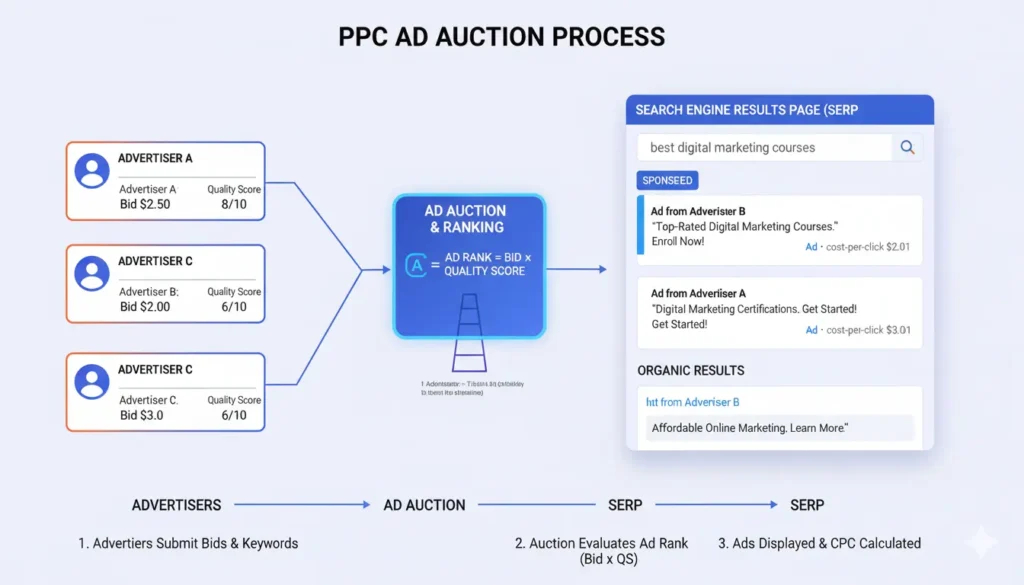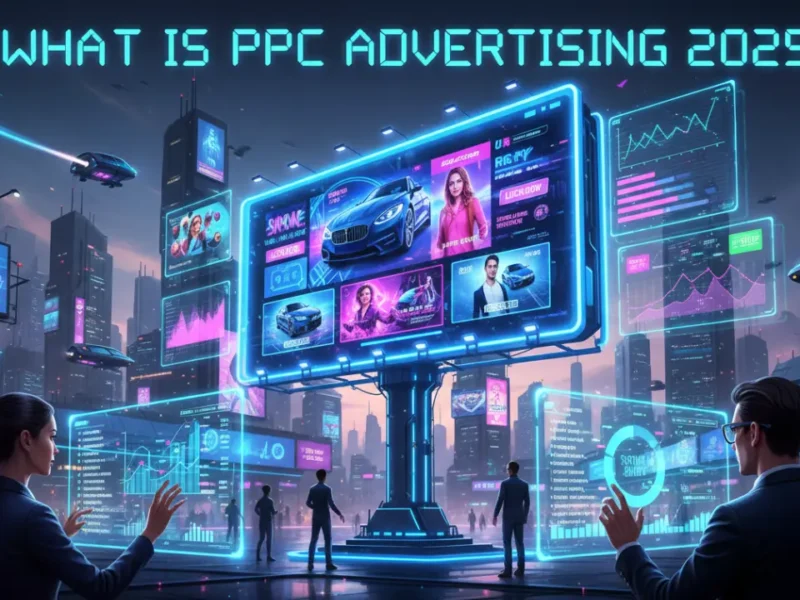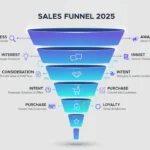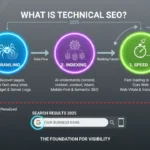So why spend a dollar to get a 1000 dollar customer? If you’re exploring performance marketing in 2025, you’re probably asking: What Is PPC Advertising, how does it actually work, and how do you use it without wasting budget? This step-by-step simplification of the whole begins with this simple beginner’s guide that simplifies it all through practical examples and time-tested tricks and techniques that you can use today.
You’ll learn:
- What Is PPC Advertising and how the auction actually works behind the scenes
- The key metrics (CTR, CPC, CPA, ROAS) and the methods of increasing it.
- Learning how to research key words, campaign, and create ads that work.
- Negative keywords, Smart bidding, Quality Score and landing page optimization.
- The most effective PPC sites in 2025 (Google Ads, Microsoft Advertising, Meta, LinkedIn).
- Checklists in practice, pitfalls to avoid, and tips of the experts.
- Answers to the most asked questions about What Is PPC Advertising
If you want hands-on help from a team that lives and breathes paid media, you can connect with us at Ghodkes: https://ghodkes.com/
Table of Contents
What Is PPC Advertising (and why it still works in 2025)
What Is PPC Advertising? PPC is an acronym used to mean pay-per-click, which is a system in which advertisers charge a fee whenever a person clicks on an advertisement. You do not get targeted traffic by organically earning visits, but by purchasing it through such services as Google Ads, Microsoft Advertising, Facebook and Instagram Ads, and LinkedIn Ads.
At a high level, What Is PPC Advertising doing for your business?
- It puts your brand in front of people already searching for your product or solution.
- It lets you control spend, scale fast, and measure returns with precision.
- It complements SEO, content, and email by filling pipeline gaps and accelerating results.
In short: What Is PPC Advertising? It’s one of the most predictable ways to get in front of high-intent customers and turn ad spend into revenue when executed with the right strategy.
How PPC works: auctions, Ad Rank, and Quality Score

When you ask, What Is PPC Advertising in practice, think about a lightning-fast auction occurring every time someone types a query into Google or Bing.
Here’s what happens in milliseconds:
- The user searches a keyword.
- The system identifies all advertisements that have similar keywords and targeting.
- The Ad Rank of each of the ads is calculated: Bid x Quality elements (planned CTR, ad relevance, landing page experience).
- The best position is given to the highest Ad Rank but at a cost that is below that of the next advertiser.
- The user sees ads, clicks, and you’re charged for that click.
Key concepts to master:
- Quality Score: Google’s diagnostic metric based on expected CTR, ad relevance, and landing page experience. Improving Quality Score reduces CPC and boosts Ad Rank. See Google’s guidance: https://support.google.com/google-ads/answer/6167122
- Ad Rank: Determines your position and eligibility for assets (sitelinks, images, callouts).
- Actual CPC: Often lower than your max bid because you pay just above the next competitor’s Ad Rank.
Understanding these mechanics is essential to really answer What Is PPC Advertising and why optimization compounds over time.
Benefits of PPC (beyond clicks)

- Speed: Launch and see results in days, not months.
- Control: Set daily budgets, cap bids, schedule ads by hour, and target by location/device.
- Measuring: Track conversion, phone calls and dollar conversion of revenue.
- Targeting: Reach your target buyer with key word intent, audiences, demographics and remarketing.
- Flexibility: Experiment with new offers, landing pages, and messages within a short period of time.
When stakeholders ask, What Is PPC Advertising bringing to the table in 2025, it’s these advantages plus smarter automation that deliver predictable growth.
PPC vs SEO: better together
Many teams wrestle with “What Is PPC Advertising vs SEO?” Both matter, but they do different jobs:
- PPC captures immediate demand and high-intent searches now.
- SEO builds authority and reduces acquisition costs long-term.
Use PPC to:
- Dominate high-intent, high-value keywords immediately
- A/B test messaging before you hard-code it into your site
- Protect your brand terms from competitors
- Fill gaps while new SEO pages rank
Use SEO to:
- Build compounding organic traffic and trust
- Rank for broader informational queries
- Reduce reliance on paid channels over time
Together they create a resilient, full-funnel strategy.
Core components of a strong PPC account
1) Account structure
- Campaigns: Group by goal (lead gen, sales, remarketing), product category, or geography.
- Ad groups: Tight themes (SKAGs are less common today; intent-based groups are smarter).
- Ads: Responsive Search Ads (RSA), Dynamic Search Ads (DSA), Display, Video, Shopping, Performance Max.
2) Keywords and match types
- Exact match: [blue running shoes] tight control, lower volume, high intent.
- Phrase match: “blue running shoes” moderate control and volume.
- Broad match: blue running shoes largest reach, relies on strong negatives and smart bidding.
Add negative keywords to block irrelevant searches and protect budget.
3) Bidding strategies (2025 reality)
- Manual CPC: Full control; good for small budgets or granular testing.
- Maximize Conversions / Maximize Conversion Value: Great for volume with conversion tracking.
- Target CPA (tCPA) and Target ROAS (ROAS): Scale efficiently once you have stable conversion data.
- Portfolio bid strategies: Share learnings across campaigns.
4) Quality Score and Ad Rank
- Improve expected CTR: Write compelling RSAs, test headlines, and use all relevant assets.
- Boost ad relevance: Align keywords to ad copy and landing page content.
- Strengthen landing page experience: Speed, clarity, and a clear call-to-action are critical.
5) Ad assets (extensions)
Use sitelinks, callouts, structured snippets, images, lead forms, prices, and call assets. Assets increase CTR and can improve Quality Score components.
6) Landing pages
- Message match: Mirror the keyword and ad promise in the hero section.
- Speed: Sub-2s load times matter (Core Web Vitals).
- CRO principles: Single goal, obvious CTA above the fold, social proof, trust badges, and minimal distractions.
The metrics that make PPC profitable

If you’re asking What Is PPC Advertising in numbers, anchor on these:
- CTR (Click-Through Rate) = Clicks / Impressions
- CPC (Cost per Click) = Cost / Clicks
- Conversion rate = Conversions / Clicks
- CPA (Cost per Acquisition) = Cost / Conversions
- ROAS (Return on Ad Spend) = Revenue / Cost
- LTV (Customer Lifetime Value): Revenue you expect per customer across time
Example:
- Spend = $1,000
- Clicks = 400 (CPC = $2.50)
- Conversions = 20 (Conversion rate = 5%)
- CPA = $50
- Revenue = $6,000
- ROAS = 6.0 (600%)
Clarity on metrics turns the question “What Is PPC Advertising doing for us?” into confident budget decisions.
Platforms to consider in 2025
- Google Ads: Search, Display, YouTube, Shopping, and Performance Max. PMax can be powerful when fed quality assets and conversion signals. Learn more: https://support.google.com/google-ads/answer/10286706
- Microsoft Advertising (Bing): Often cheaper CPCs and strong for B2B; integrates with LinkedIn profiles. Docs: https://learn.microsoft.com/advertising
- Meta Ads (Facebook/Instagram): Excellent for prospecting and remarketing with creative-led campaigns. https://www.facebook.com/business/ads
- LinkedIn Ads: High-quality B2B targeting (job title, industry, company size). Higher CPCs but strong lead quality.
- YouTube: Top-of-funnel awareness and powerful remarketing with video.
As you weigh What Is PPC Advertising best used for, match platforms to your audience and buying journey.
Step-by-step: from zero to your first profitable campaign
Step 1: Define goals and attribution
- What are you optimizing for? Leads, sales, booked demos, calls?
- What is a qualified lead worth? What’s your target CPA or ROAS?
- Choose attribution: Use data-driven attribution in Google Ads/GA4 where available.
Step 2: Install tracking and verify conversions
- Google Ads conversion tag or via Google Tag Manager
- GA4 events and conversions: https://support.google.com/analytics/answer/10759417
- Import conversions to Google Ads for smarter bidding
- Use UTMs for cross-channel clarity
- Consider call tracking and offline conversion imports for sales-qualified leads
Without accurate tracking, you can’t answer What Is PPC Advertising delivering day-to-day.
Step 3: Keyword and audience research
- Start with Google Keyword Planner, Google Trends, AnswerThePublic, and your own search term data.
- Group by intent: transactional (buy, pricing), commercial investigation (best, compare), informational (how to).
- Build a seed list, then expand with phrase and broad match while preparing a strong negative list.
Step 4: Build a clean campaign structure
- Separate Brand, Non-Brand, Competitor, and Remarketing campaigns.
- Segment by match type or intent buckets.
- Keep themes tight so RSAs stay relevant.
Step 5: Write high-converting RSAs
Use high-intent headlines and benefits:
- Include primary keyword and unique value proposition.
- Add proof points: reviews, guarantees, certifications.
- Test 2–3 RSAs per ad group with varied angles.
Headline ideas:
- “Get [Product] in 24 Hours Free Returns”
- “Compare [Solution] Plans See Pricing”
- “Rated #1 for [Benefit] Book a Demo”
Step 6: Design a fast, focused landing page
- Clear headline matching the ad’s promise
- Visual proof: testimonials, star ratings, logos, case snippets
- Single call-to-action (Buy Now, Book Demo, Get Quote)
- Short form (only essential fields)
- Mobile-first layout, fast load times
Step 7: Launch checklist
- Conversion tracking tested
- Location and language targeting verified
- Ad schedule set (if needed)
- Negative keywords added
- Budgets and bidding aligned with goals
- Ad assets attached (sitelinks, callouts, images, structured snippets)
- Billing and account settings verified
When people ask teammates What Is PPC Advertising going to look like in our account, this build process is your blueprint.
Optimization: the weekly rhythm that compounds results
- Search terms review: Add negatives, elevate winning queries to exact match.
- RSA optimization: Pin critical headlines when necessary; test new benefits and objections.
- Bids and budgets: Shift spend to high-ROAS ad groups and pause waste.
- Audiences: Layer in remarketing, in-market, and custom segments; adjust bid modifiers for devices and geos.
- Landing page testing: A/B test headlines, forms, social proof, FAQs near the CTA.
- Quality Score: Improve ad relevance and landing speed; update keyword-to-ad alignment.
Pro tip: Document every test and result. Over time, this becomes living proof when leadership asks again: What Is PPC Advertising doing to lower CPA and lift revenue?
Remarketing and full-funnel PPC
What Is PPC Advertising without remarketing? Incomplete. Remarketing turns window shoppers into buyers.
- Site remarketing: Re-engage visitors who didn’t convert.
- Dynamic remarketing: Show products users viewed (ecommerce).
- List uploads: Reach past customers and subscribers.
- Lookalikes (or similar audiences): Prospect new users aligned to your best converters.
Sequence your messaging:
- First visit: Problem/solution + value proposition.
- Remarketing pass 1: Social proof + offer (free shipping, extended trial).
- Remarketing pass 2: Scarcity/urgency + guarantee.
B2B PPC nuances
In B2B, the story changes. Longer cycles, more stakeholders, higher stakes.
- Match keywords to buying stages (awareness, consideration, decision).
- Use LinkedIn and Microsoft audience layering for role-based targeting.
- Offer content that aligns to stage (guide, case study, ROI calculator).
- Track qualified lead (MQL/SQL) and pipeline, not just lead volume.
- Import offline conversions back into Google Ads to train bidding systems.
When a sales-led org asks What Is PPC Advertising doing for pipeline, map ads to stages and measure beyond raw form fills.
Budgeting, pacing, and forecasting
- Start with your CPA or ROAS target and reverse-engineer.
- Example: If target CPA is $100 and conversion rate is 5%, your max CPC should hover near $5 (assuming no margins or LTV considerations). With higher LTV, you can afford a higher CPC.
- Pacing: Check spend vs. plan daily in the first two weeks. Adjust budgets and bids to avoid end-of-month surges.
- Impression share: If your top queries have low impression share due to budget, capture that first before expanding.
Common mistakes that waste money
- No conversion tracking or incorrect goals (e.g., counting page views as leads)
- Mixed intents in the same ad group (weakens relevance)
- Ignoring search terms and negatives
- Sending all traffic to the homepage
- Overusing broad match without strong negatives and conversion data
- Not adapting bids for devices, locations, and hours
- Setting and forgetting ad assets
- Failing to ask: What Is PPC Advertising trying to achieve in this specific campaign?
Compliance, privacy, and policy basics
- Follow advertising policies (restricted industries, claims, trademarks).
- Respect user privacy (GDPR/CCPA) and consent for tracking.
- Use first-party data where possible; implement server-side tagging if appropriate.
- Review Google Ads policies and privacy guidelines: https://policies.google.com/technologies/ads
Trust and compliance directly impact performance and brand reputation.
Tools that make PPC easier
- Google Keyword Planner, Google Trends
- Google Tag Manager, GA4, Looker Studio dashboards
- Google Ads Editor for bulk edits
- Auction Insights and Search Terms reports
- Competitive research: Semrush, Ahrefs, SpyFu
- Landing page/CRO: Hotjar, VWO, Unbounce, Webflow
- Page speed: PageSpeed Insights, Lighthouse
If you’d like expert help setting these up right, reach out at https://ghodkes.com/
Quick-reference tables
Match types at a glance
| Match Type | Example Keyword | Triggers Searches Like | Control | Volume |
| Exact | [running shoes] | running shoes | High | Low |
| Phrase | “running shoes” | best running shoes for men | Medium | Medium |
| Broad | running shoes | footwear for marathon | Low | High |
Key formulas
- CPA = Cost / Conversions
- ROAS = Revenue / Cost
- Conv. Rate = Conversions / Clicks
- CPC = Cost / Clicks
Keep these near your dashboard to translate “What Is PPC Advertising performance today?” into decisions.
PPC glossary (2025)
- PPC: Pay-per-click; you pay when users click.
- RSA: Responsive Search Ads; Google mixes headlines and descriptions dynamically.
- DSA: Dynamic Search Ads; Google matches landing pages to queries automatically.
- PMax: Performance Max; goal-based campaigns across Google inventory with asset groups.
- Quality Score: Diagnostic for keyword relevance and landing experience.
- Ad Rank: Determines ad position; mixes bid and quality components.
- CTR/CPC/CPA/ROAS: Core performance metrics.
- Negative keywords: Block irrelevant queries to prevent waste.
- Remarketing/Retargeting: Target users who visited or interacted previously.
- Lead form asset: Collect leads directly from the SERP.
Mastering these terms makes answering What Is PPC Advertising across your team straightforward and consistent.
Realistic paths to scale
- Capture brand demand first; protect your name from competitors.
- Own a core set of high-intent non-brand keywords with solid Quality Scores.
- Broaden carefully with phrase and broad + robust negative management.
- Layer audiences and test tailored messaging for each segment.
- Diversify into Microsoft Ads for incremental volume at often lower CPCs.
- Add remarketing to reduce CAC and lift LTV.
- Iterate on landing pages relentlessly CRO is the biggest lever.
No single lever answers What Is PPC Advertising success compound small wins weekly.
When to use each campaign type
- Performance Max: Ecommerce or multi-signal lead gen with strong creative and conversion data.
- Shopping (Standard/Smart): Ecommerce product feeds; pair with search for coverage.
- Display: Retargeting, awareness, and low-cost reach; measure assisted conversions.
- YouTube: Awareness and remarketing; powerful storytelling.
- Local campaigns / Local Services Ads: Store visits, service area businesses; call-driven.
Choosing the right mix is part of solving What Is PPC Advertising for your unique funnel.
Conclusion: Turn clicks into customers consistently
You came in asking, What Is PPC Advertising and how do I use it in 2025 without burning budget? Now you’ve got the full playbook: how the auction works, which metrics matter, how to structure campaigns, write persuasive ads, optimize landing pages, build remarketing, and scale with confidence. The secret isn’t one “hack”it’s steady execution, week after week.
If you want expert eyes to plan, launch, and optimize with you, we’re here to help.
- Book a free 1:1 PPC strategy session today and get a tailored plan for your business: https://ghodkes.com/
- Prefer email? Reach out via our site and we’ll respond within 24 hours with next steps.
Bonus checklist: launch and optimization
- Confirm goal tracking (Google Ads tag + GA4)
- Define target CPA or ROAS
- Build Brand, Non-Brand, Competitor, Remarketing campaigns
- Use phrase/exact to start; add broad with negatives once stable
- Write 2–3 RSAs per ad group; attach all relevant assets
- Create a fast, single-goal landing page with strong proof
- Review search terms twice weekly and add negatives
- Reallocate budget to winning ad groups and keywords
- Test one variable at a time (headline, offer, form length)
- Ask weekly: What Is PPC Advertising doing for our KPIs and what’s the next best test?
Frequently Asked Questions About PPC
What Is PPC Advertising?
PPC is pay-per-click advertising where you pay platforms like Google or Microsoft when someone clicks your ad. It’s a measurable way to buy targeted traffic and conversions.
How much does PPC cost?
Costs vary by industry and competition. CPCs can range from $0.50 to $50+. Start with a test budget, set clear CPA/ROAS targets, and scale what works.
Is PPC better than SEO?
They serve different purposes. PPC delivers immediate traffic and data. SEO compounds long-term. Use both for a balanced strategy.
What Is PPC Advertising on Google vs Microsoft?
On Google Ads, you reach the largest search audience. Microsoft Advertising (Bing) often has cheaper CPCs and strong B2B intent. Both use auctions, keywords, and quality signals.
How do I measure success?
Track conversions, CPA, ROAS, and LTV. Ask, What Is PPC Advertising contributing to revenue and pipeline? Optimize bids, ads, and landing pages accordingly.
Do I need a landing page?
Yes. Align the page to the keyword and ad promise. Fast load times, one clear CTA, and strong social proof are essential.








